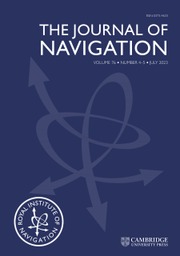No CrossRef data available.
Article contents
The Plane Scale and stereographic projection in early navigation
Published online by Cambridge University Press: 20 June 2025
Abstract
The Plane or Plain Scale is a navigational device that dates back to the early 1600s but has long since ceased to be used in practice. It could perform the function of a protractor and be used to solve problems in plane trigonometry. In addition, coupled with a suite of remarkable geometric constructions based on stereographic projection, the Plane Scale could efficiently solve problems in spherical trigonometry and hence navigation on a sphere. The methods used seem today to be largely unknown. This paper describes the Plane Scale and how it was used.
Keywords
Information
- Type
- Research Article
- Information
- Copyright
- © The Author(s), 2025. Published by Cambridge University Press on behalf of The Royal Institute of Navigation
References
Aspley, J. (1624). Speculum Nauticum. A Looking Glasse for Sea-Men; London, Thomas Harper. Available at: https://archive.org/details/bim_early-english-books-1475-1640_speculum-nauticum-_aspley-john_1624
Google Scholar
Bion, M. (1723). The Construction and Principal Uses of Mathematical Instruments. London: John Senex & William Taylor. Available at: https://archive.org/details/constructionprin00bion/page/n3/mode/2up
Google Scholar
Bowditch, N. (1851). The New American Practical Navigator (20
th
Edition), New York, E. & G. W. Blunt. Available at: https://books.google.com/books?id=DWxGAAAAYAAJ
Google Scholar
Collins, J. (1659). The Mariner’s Plain Scale New Plain’d; London, Fr. Cossinet. Available at https://books.google.com/books/about/The_Mariners_Plain_Scale_New_Plain_d.html?id=nx4SuwEACAAJ
Google Scholar
Mackay, A. (1802). The Description and Use of the Sliding Gunter in Navigation. London: J. Burnett. Available at: https://books.google.com/books/about/The_Description_and_Use_of_the_Sliding_G.html?id=EG5GAAAAYAAJ
Google Scholar
Stuart, R. G. (1984). Applications of Complex Analysis to Spherical Coordinate Geometry. Quarterly Journal of the Royal Astronomical Society, 25, 126–136. Available at https://ui.adsabs.harvard.edu/link_gateway/1984QJRAS.25.126S/ADS_PDF
Google Scholar
Stuart, R. G. (2009a) Applications of Complex Analysis to Precession, Nutation and Aberration. Monthly Notices of the Royal Astronomical Society, 400, 1366–1372. Available at: https://academic.oup.com/mnras/article/400/3/1366/960867
CrossRefGoogle Scholar
Stuart, R. G. (2009b) Applications of Complex Analysis to Celestial Navigation. NAVIGATION: Journal of the Institute of Navigation, 56, 221–227.CrossRefGoogle Scholar
Stuart, R. G. (2017) Great Circles and Rhumb Lines on the Complex Plane. The Journal of Navigation, 70, 618–627.CrossRefGoogle Scholar
van Poelje, O. (2004a). Gunter Rules in Navigation. Journal of the Oughtred Society, 13 (1), 11–21. Available at: https://eeuwen.home.xs4all.nl/images/Pics/Kombuispraat/Pleinschaal/200404 Gunter Rules in Navigation V13-1.pdfGoogle Scholar
van Poelje, O. (2004b). Diagonals and Transversals: Magnifying the Scale. Journal of the Oughtred Society, 13 (2), 22–28. Avalable at: https://osgalleries.org/journal/pdf_files/13.2/V13.2P22.pdf
Google Scholar
Waters, D. W, (1958). The Art of Navigation in England in Elizabethan and Early Stuart Times, London, Hollis and Carter. Available at: https://archive.org/details/in.ernet.dli.2015.51856
Google Scholar


